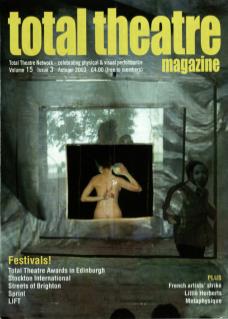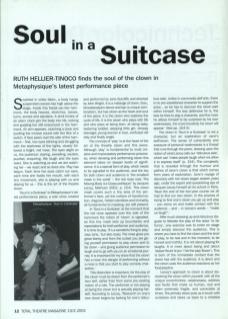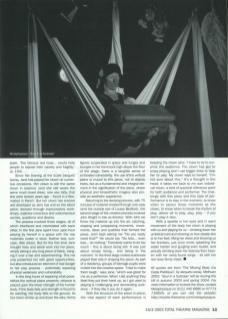Swathed in white fabric, a body hangs suspended cocoon-like high above the stage. Inside this foetal-sac-like hammock, the body heaves, stretches, tosses turns, snores and splutters. A shrill timbre of an alarm clock jars the body into life, kicking and gurgling but still ensconced in the hammock. An arm appears, clutching a clock and quelling the incisive sound with the flick of a switch. A face peers over the side of the hammock – first, two eyes blinking and struggling with the starkness of the lights, closely followed by a bright, red nose. The eyes alight on us, the audience: staring, swivelling, excited, puzzled, enquiring. We laugh and the eyes react. She is watching us and we are watching her – we react and so does she. Play has begun. Each time her eyes catch our eyes, each time she twists her mouth, with each tiny movement, she is playing with us and playing for us – this is the art of the theatre clown.
Soul in a Suitcase is Metaphysique's latest performance piece, a solo show created and performed by Jane Sutcliffe and directed by John Wright. It is a mélange of clown, tissu, bharatanatyam dance and tap (a unique combination), but has clown as the heart and soul of the piece. It is the clown who explores the cycle of life. It is the clown who plays with life and who plays at being born, at being a baby, teetering toddler, skipping little girl, stroppy teenager, young woman in love, confused old lady and finally angel.
The concept of 'play' is at the heart of the art of the theatre clown and this piece. Although 'play' is fundamental to most creative and improvisatory performance processes, when devising and performing clown this element takes on deeper levels of significance. It is a special form of play, which needs to be signalled to the audience, and the key for both clown and audience is the ‘smallest mask in the world’ – the red nose (see The Moving Body (Le Corps poétique) by Jacques Lecoq, Methuen 2002, p. 154). This clown mask covers such a tiny area of the performer's face, yet the notions of transformation, disguise, hidden identities and liminality, all fundamental to masking, are still present.
In Soul in a Suitcase at the moment that the red nose appears over the side of the hammock the notion of 'clown' is signalled, as this tiny mask sets up boundaries and expectations for both performer and audience. It is time to play. ‘It's a wonderful thing to play,’ says Jane, ‘but also scary. The nose gives you great liberty and from the outset you are giving yourself permission to play clown and to be clown – and giving audience permission to laugh and to go with you on an emotional journey. It is important for my show that the clown has a nose; the danger of performing without a nose is that you start to play comedy characters.'
This distinction is important, for the play of the clown must be drawn from the performer's own self, rather than from some pre-existing notion of a role. The performer is not playing at being the clown but is actually playing herself. According to Lecoq, ‘Research on one's own clown begins by looking for one's ridiculous side. Unlike in commedia dell'arte, there is no pre-established character to support the actor... so he has to discover the clown part within himself. The less defensive he is, the less he tries to play a character, and the more he allows himself to be surprised by his own weaknesses, the more forcefully his clown will appear.’ (ibid pp. 154-5)
The clown in Soul in a Suitcase is not a character, but an exploration of Jane's self/clown. The sense of vulnerability and exposure of personal weaknesses is a thread that runs through the piece, drawing upon the notion of what Lecoq calls our ‘ridiculous side', which can make people laugh when we allow it to express itself (p. 154). The complexity that is revealed through the humour and pathos of Jane's clown is that which comes from years of exploration. Jane's voyage of discovery with her clown began sixteen years ago, under the expert and questioning eye of Jacques Lecoq himself at his school in Paris. ‘Near the end of the two-year course we all had to find our own clown. In the process of trying to find one's clown you go up and play – you come on and make contact with the audience – and – in Lecoq's words – “make us laugh".'
After much dressing up and ridiculous disguise to liberate the play of the actor ‘to be funny’, one exercise was to enter on stage and simply discover the audience. This is where you have to find the clown and the level of play, to be real and in the moment, to be honest and truthful. It is not about playing for laughs. It is more about being and about ‘laisser fleurir le jeu' ('let the play flower'). This is born of the immediate contact that the clown has with the audience. It is direct and the clown uses the audience reactions as her food/playline.
Lecoq's approach to clown is about discovering the clown within yourself with all the unique eccentricities, weaknesses, oddities and faults that make us human, real and often extremely fragile, and vulnerable at times. The primary clown puts us in touch with ourselves and takes us back to a childlike state. ‘The famous red nose... would help people to expose their naivety and fragility.’ (p. 154)
Since her training at the Ecole Jacques Lecoq, Jane has played her clown on numerous occasions. Her clown is still the same clown in essence (and she still wears the same much-loved dress, now very tatty, that she wore sixteen years ago – found in a fleamarket in Paris!). But her clown has evolved and developed as Jane has and so this latest piece, devised through improvisatory workshops, explores conscious and subconscious worries, questions and desires.
The process involved three stages, all of which interfaced and interrelated with each other. In the first Jane spent hour upon hour playing by herself in a space with the raw materials (water in bowl, feather boa, suitcase, little dress). But for the first time Jane brought tissu and aerial work into her piece, simply taking a very long piece of fabric, hanging it over a bar and experimenting. This not only presented her with great opportunities, but also introduced an element of real danger to her play process – potentially exposing physical weakness and vulnerability.
In the long hours of exploring what possibilities the vertical plane presents, reliance is placed upon the sheer strength of the human body. If the body fails and strength is found to be wanting, the body falls to the ground. As her clown climbs up and down the silks, forms figures suspended in space, and lunges and lounges in her hammock high above the floor of the stage, there is a tangible sense of embodied vulnerability. The use of the vertical plane is crucial to this piece, not to display tricks, but as a fundamental and integral element in the signification of the piece, where physical and kinaesthetic imagery also provide an aesthetic experience.
Returning to the devising process, with 75 minutes of material created through solo-play (and the outside eye of Louise Bedford), the second stage of the creative process involved John Wright in role as director. ‘With John we threw the material up into the air, catching, shaping and juxtaposing moments, movements, ideas and qualities that formed the piece. John kept asking me "Do you really need that?" He would say "Do less... even less... do nothing." Everybody wants to do too much – this is about being still. It was just about simply being... and being in the moment.’ In the third stage invited audiences played their role in shaping the piece. As part of a residency, groups of teenage pupils were invited into the creative space. 'I had to make them laugh,' says Jane, ‘which was great for me as a performer. When I did anything they liked they put their hand up, so I got used to playing a challenging and demanding audience – if they like it you do it again.'
With the structure of the piece in place, the vital aspect of each performance is keeping the clown alive. I have to try to surprise the audience. The clown has got to enjoy playing and I use trigger lines to help her to play. My clown says to herself, ‘I'm not sure about this.’ It's a thought in the head; it takes me back to my own individual clown, a kind of quizzical reference point for both audience and performer. The challenge with this piece and this style of performance is to stay in the moment, to know when to savour those moments as the clown, to know when to break the rhythm of play, above all to play, play, play – if you don't play it dies.
With a sparkle in her eyes and in each movement of the body her clown is playing with us and playing for us – climbing down her umbilical cord and showing us how steady she is on her feet; lifting her dress and showing us her knickers, just once more; splashing the water harder and gurgling even louder, and proudly climbing down her stairway from heaven with her newly found wings – all with her red nose firmly intact.
All quotes are from The Moving Body (Le Corps Poétique), by Jacques Lecoq, Methuen 2002. Soul in a Suitcase will be touring the UK in autumn 2003 and spring 2004. For more information or to book the show, contact Metaphysique on 0121 440 6880 or 07773 716845, or you can visit the website: http://mysite.freeserve.com/metaphysique.


